- Home
- »
- Agrochemicals & Fertilizers
- »
-
Post-harvest Treatment Market Size And Share Report, 2030GVR Report cover
![Post-harvest Treatment Market Size, Share & Trends Report]()
Post-harvest Treatment Market Size, Share & Trends Analysis Report By Type, By Crop Type (Fruits & Vegetables, Flowers & Ornamentals, Other Crop Types), By Origin (Natural, Synthetic), By Region, And Segment Forecasts, 2024 - 2030
- Report ID: GVR-4-68040-265-0
- Number of Report Pages: 80
- Format: PDF, Horizon Databook
- Historical Range: 2018 - 2023
- Forecast Period: 2024 - 2030
- Industry: Bulk Chemicals
Post-harvest Treatment Market Size & Trends
The global post-harvest treatment market size was estimated at USD 2.01 billion in 2023 and is projected to grow at a CAGR of 7.3% from 2024 to 2030. This is attributed to the rising demand for fresh produce alongside a growing awareness of food waste. People worldwide are consuming more fresh fruits and vegetables than ever. This is due to an increasing awareness of the health benefits of a fresh produce-rich diet. This rise in demand puts pressure on the supply chain to keep this produce fresh and available for longer.
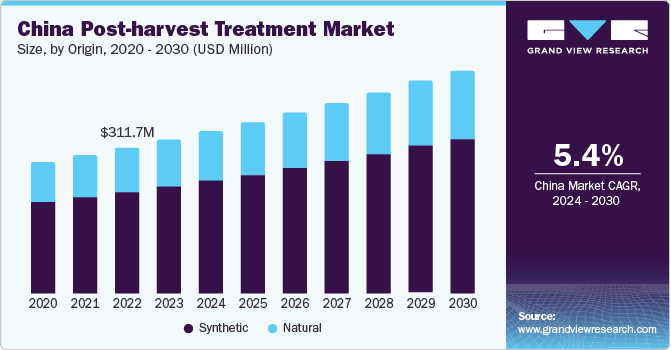
A significant portion of fruits and vegetables spoil between harvest and consumption. Post-harvest treatments can significantly reduce this waste, making the produce industry more sustainable and efficient. With globalization and complex supply chains, fruits and vegetables often travel long distances before reaching consumers. It helps extend shelf life, allowing producers to reach new markets and consumers to enjoy a wider variety of fresh produce.
Many consumers are concerned about the use of synthetic chemicals in their food. Natural techniques are gaining popularity as they offer a way to maintain freshness without artificial preservatives. Some conventional techniques can leave chemical residues on produce. Natural treatments address this concern, potentially making the food safer for consumers.
Market Concentration & Characteristics
The market is moderately fragmented, with rising investments in setting up new production facilities worldwide to meet the increasing market demand globally. With growing demand patterns, companies such as JBT, Syngenta Crop Protection, Nufarm, Bayer AG, BASF SE, Citrosol, Hazel Technologies Inc., Lytone Enterprise Inc., Janssen PNP, and Futureco Chemicals Inc., among others, are increasing their production capacities. Moreover, the industry is primarily characterized by the dominance of domestic companies in respective countries.
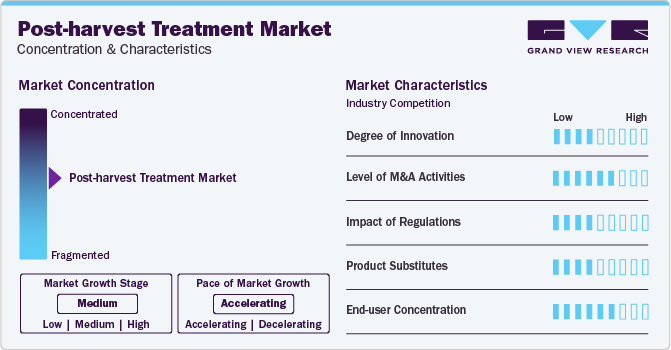
These companies have a strong presence in the market, offering a wide range of conventional techniques like fungicides, waxes, and coatings. They benefit from established distribution networks and brand recognition. Driven by consumer preference, there's a growing number of companies specializing in natural post-harvest treatments. These include providers of bio-coatings, essential oil washes, and beneficial microbes.
Type Insights
Based on type, the coatings segment dominated the global market with a revenue share of over 31.3% in 2023. This growth is attributed to their ability to offer a multi-layered approach to extending shelf life and preserving quality. Coatings act as a thin, physical barrier that reduces water loss from the produce. This helps to maintain firmness, texture, and weight.
Selective coatings can regulate the exchange of gases like oxygen (O2) and carbon dioxide (CO2) between the fruit or vegetable and its environment. This can slow down respiration, a natural process contributing to ripening and spoilage. Coatings can significantly reduce post-harvest losses by keeping fruits and vegetables fresh longer. This benefits both producers and consumers.
In post-harvest treatment, cleaners play a vital role in ensuring the safety and quality of fruits and vegetables. Fruits and vegetables can be contaminated during harvest, transportation, and storage. This can include dirt, debris, insects, and harmful pathogens like bacteria and mold spores. Cleaning removes these contaminants, reducing the risk of foodborne illness and extending the shelf life of the produce.
Crop Type Insights
Based on crop type, the fruits & vegetables segment dominated the global market in 2023. This growth is attributed to its ability to slow down these processes and maintain the quality and freshness of the produce for as long as possible. After harvest, fruits and vegetables respire, releasing water vapor and carbon dioxide. This process uses up their sugars and nutrients, leading to wilting, softening, and eventually spoilage. Techniques like proper storage temperature, controlled atmosphere storage, and coatings can slow down respiration and extend shelf life.
Flowers, like fruits and vegetables, are living things that continue biological processes even after they are cut from the plant. Post-harvest treatment for flowers is crucial to extend their beauty and enjoyment in a vase for as long as possible. Cut flowers lose water through transpiration, the process by which plants release water vapor from their leaves and stems.
Techniques like re-cutting stems, using hydrating solutions, and proper storage temperatures help the flowers take up water more efficiently and stay hydrated for longer, keeping them fresh and vibrant. Loss of water pressure leads to wilting and bent necks in flowers. Post-harvest treatments like support structures and conditioning solutions with specific sugar and acidity levels help maintain cell turgor (pressure) and prevent these issues.
Origin Insights
Based on origin, the synthetic segment dominated the global market in 2023 because it controls spoilage, extends shelf life, and prevents diseases. In some cases, they may be the only proven option for specific fruits and vegetables, especially for long-distance transport or storage. For large-scale producers, synthetic treatments can sometimes be more cost-effective than newer natural alternatives. The infrastructure and application methods for synthetics may already be established, requiring less investment than adopting new technologies.
Many consumers are increasingly concerned about using synthetic chemicals in their food. Natural treatments extend shelf life and maintain quality without artificial preservatives, appealing to health-conscious consumers. Some conventional techniques can leave chemical residues on produce. Natural treatments address this concern, potentially making the food safer for consumers. Natural treatments are often more environmentally friendly than conventional methods. They may not require as much energy or generate harmful byproducts, reducing the environmental impact of food production.
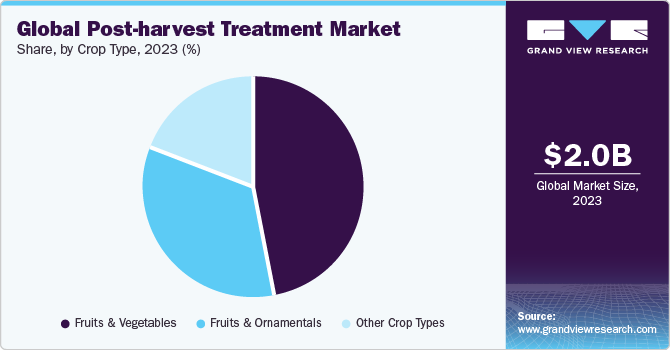
While the trend is toward natural options, some consumers may not be willing to pay a premium for them. This can influence producer decisions, especially for large retailers and supermarkets with tight profit margins. Some natural treatments may require additional infrastructure or equipment that small-scale farmers may not have access to or cannot afford. Synthetics may be a more practical option in such cases.
Regional Insights
North American consumers have a high demand for fresh, high-quality fruits and vegetables. It helps maintain the appearance, texture, flavor, and nutritional value of produce for longer, meeting these expectations. Busy lifestyles lead to a preference for convenient and readily available fresh produce. It extends shelf life, allowing consumers to buy fruits and vegetables less frequently and reducing food waste at home.
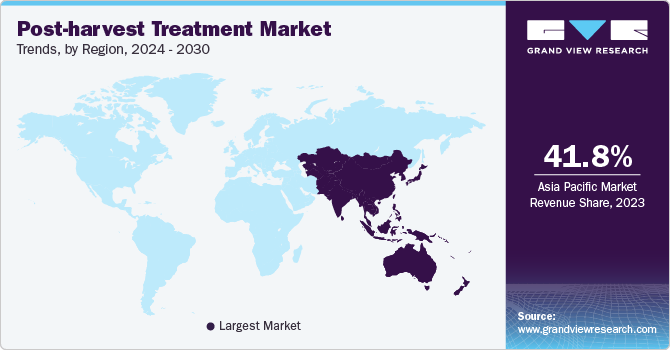
U.S. Post-harvest Treatment Market Trends
The post-harvest treatment market in the U.S., concerns about foodborne illness and pesticide residue drive demand for safer produce. Natural techniques offer an alternative to synthetic chemicals, potentially reducing pesticide residue on fruits and vegetables.
Asia Pacific Post-harvest Treatment Market Trends
Asia Pacific dominated the market segment with a revenue share of 41.8% in 2023, attributed to the growing population, leading to a higher demand for fresh fruits and vegetables. This pressures the agricultural sector to produce more and minimize food waste throughout the supply chain. Post-harvest treatments can significantly extend shelf life and reduce spoilage, ensuring more produce reaches consumers.
The China post-harvest treatment market is growing as the country is the world's most populous country, and ensuring food security for its citizens is a top priority. These techniques can significantly reduce food waste throughout the supply chain, maximizing the amount of fresh produce available for consumption. China is a major exporter of fruits and vegetables, and maintaining quality during long-distance transport is crucial. Post-harvest treatments extend shelf life and improve appearance, making Chinese produce more competitive globally.
The post-harvest treatment market in India has a notoriously high rate of post-harvest losses, estimated at around 30-40% for fruits and vegetables. This translates to a significant amount of wasted food and lost income for farmers. These techniques offer a way to significantly reduce spoilage, improve efficiency, and maximize the value of agricultural produce.
Europe Post-harvest Treatment Market Trends
European consumers have a high standard for fresh produce, demanding fruits and vegetables that are flavorful, nutritious, and visually appealing. These techniques help maintain these qualities for longer, meeting consumer expectations. European consumers are concerned about food safety and pesticide residue. Natural techniques offer an alternative to synthetic chemicals, potentially reducing risks associated with foodborne illness and chemical residue.
Following Brexit, the UK has more independence in setting its food safety regulations. This could lead to a greater emphasis on domestic food production and increased reliance on these techniques to maintain the quality of locally grown produce. The UK still imports many fruits and vegetables from Europe and other parts of the world. It ensures that the quality of the produce is met during longer journeys and that it meets import standards.
The Germany post-harvest treatment market is growing as the country is a significant exporter of agricultural products within the EU. Post-harvest treatments are essential for ensuring the quality of German produce during transport to other European markets, maintaining its competitiveness. German agriculture adheres to strict quality standards. It helps producers ensure their fruits and vegetables meet these standards and remain marketable for extended periods.
Central & South America Post-harvest Treatment Market Trends
Investments in cold chain infrastructure and improved transportation networks are opening up new opportunities for broader distribution of fresh produce within the region and for export. It ensures fruits and vegetables can travel longer distances and maintain quality throughout the supply chain. Food security is a significant concern in some parts of Central and South America. These techniques can help minimize spoilage and ensure a more consistent fresh produce supply, contributing to food security.
The post-harvest treatment market in Brazil suffers from significant post-harvest losses, estimated at around 30-40% for fruits and vegetables. This translates to a substantial amount of wasted food, lost income for farmers, and limited produce availability for consumers. These techniques offer a way to significantly reduce spoilage throughout the supply chain, improve efficiency, and maximize the value of Brazilian agriculture.
Middle East & Africa Post-harvest Treatment Market Trends
Many Middle East & Africa (MEA) countries lack developed cold chain infrastructure, and the region experiences hot and dry climates. These factors present significant challenges to maintaining the quality of fresh produce. Post-harvest treatments offer alternative solutions that can be more adaptable to these conditions. MEA governments recognize the importance of reducing food waste and boosting agricultural productivity. There are initiatives to improve post-harvest infrastructure, promote research on new treatment technologies suited to the region's climate, and encourage farmers' adoption of these methods.
The South Africa post-harvest treatment market is growing as the country has a range of climates, from subtropical to arid. Post-harvest treatments must be adapted to address specific challenges in different regions, like managing high humidity in coastal areas or extending shelf life in drier regions. There's a growing focus on environmentally friendly post-harvest treatments in South Africa. Research on natural and biodegradable options is gaining traction, aligning with global trends towards sustainable agriculture.
Key Post-Harvest Treatment Company Insights
Some of the key players operating in the market include BASF SE, Syngenta Crop Protection, Nufarm, and Bayer AG among others:
-
BASF SE is a chemical manufacturing company. The company operates through five business segments, namely performance products, chemicals, agricultural solutions, functional materials & solutions, and oil & gas. It caters its products to several end-use industries, such as pharmaceuticals, automotive & transportation, agriculture, construction, electronics & electric, personal care & hygiene, energy & resources, furniture & wood, home care and industrial & institutional cleaning solutions, nutrition, packaging & print, paints & coatings, pulp & paper, textile, plastics & rubber, leather & footwear, among others.
-
The Bayer AG is a German multinational pharmaceutical and biotechnology company and is one of the largest pharmaceutical companies and biomedical companies in the world
JBT, Citrosol, Hazel Technologies Inc., Lytone Enterprise Inc., Janssen PNP, and Futureco Chemicals Inc among others, are some of the emerging market participants.
-
Hazel is driven to develop innovative, AgTech solutions that reduce waste at every stage in the produce journey and give multi-national growers and buyers a new sense of confidence as they navigate increasingly complex global supply chains.
-
Futureco Bioscience is an organic fertilizer and phytosanitary company, specialized in the manufacture of high quality biostimulants and natural pesticides for crop protection. Futureco Bioscience, which began its trajectory in 1993 in Catalonia, (Spain) develops its own lines of research to obtain new products (biostimulants such as rooting agents, amino acids, algae, phosphorus solubilizers, and biocontrol products such as fungicides, bactericides, and zero residue insecticides) that optimize crop yields, without risks to the environment.
Key Post-Harvest Treatment Companies:
The following are the leading companies in the post-harvest treatment market. These companies collectively hold the largest market share and dictate industry trends.
- JBT
- Syngenta Crop Protection
- Nufarm
- Bayer AG
- BASF SE
- Citrosol
- Hazel Technologies Inc.
- Lytone Enterprise Inc.
- Janssen PNP
- Futureco Chemicals Inc.
Recent Developments
-
In May 2023, KitoZyme and Janssen PMP, signed an Exclusive Collaboration Agreement to evaluate and develop KitoZyme technologies for post-harvest use on fresh produce.
-
In January 2022, Syngenta AG launched a new fungicide named Archive to control the diseases occurring during the post-harvest.
Post-harvest Treatment Market Report Scope
Report Attribute
Details
Market size value in 2024
USD 2.03 billion
Revenue forecast in 2030
USD 3.09 billion
Growth rate
CAGR of 7.3% from 2024 to 2030
Historical data
2018 - 2023
Forecast period
2024 - 2030
Quantitative units
Volume in Kilotons, Revenue in USD million/billion and CAGR from 2024 to 2030
Report coverage
Volume and revenue forecast, company ranking, competitive landscape, growth factors, and trends
Segments covered
Type, crop type, origin, region
Regional scope
North America; Europe; Asia Pacific; Central & South America; and Middle East & Africa
Country scope
U.S.; Canada; Mexico; Germany; U.K.; France; Italy; Spain; China; India; Japan; South Korea; Brazil; Argentina; South Africa; Saudi Arabia
Key companies profiled
JBT; Syngenta Crop Protection; Nufarm; Bayer AG; BASF SE; Citrosol; Hazel Technologies Inc.; Lytone Enterprise Inc.; Janssen PNP
Customization scope
Free report customization (equivalent up to 8 analysts working days) with purchase. Addition or alteration to country, regional & segment scope.
Pricing and purchase options
Avail customized purchase options to meet your exact research needs. Explore purchase options
Global Post-harvest Treatment Market Report Segmentation
This report forecasts volume and revenue growth at global, regional, and country levels and provides an analysis of the latest industry trends in each of the sub-segments from 2018 to 2030. For this study, Grand View Research has segmented the global post-harvest treatment market report based on type, crop type, origin, and region.
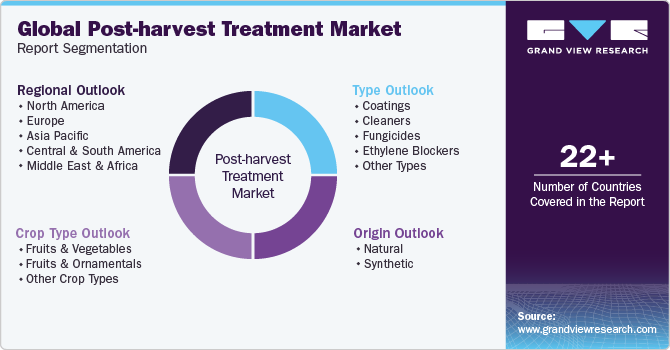
-
Type Outlook (Volume, Kilotons; Revenue, USD Million, 2018 - 2030)
-
Coatings
-
Cleaners
-
Fungicides
-
Ethylene Blockers
-
Other Types
-
-
Crop Type Outlook (Volume, Kilotons; Revenue, USD Million, 2018 - 2030)
-
Fruits & Vegetables
-
Fruits & Ornamentals
-
Other Crop types
-
-
Origin Outlook (Volume, Kilotons; Revenue, USD Million, 2018 - 2030)
-
Natural
-
Synthetic
-
-
Regional Outlook (Volume, Kilotons; Revenue, USD Million, 2018 - 2030)
-
North America
-
U.S.
-
Canada
-
Mexico
-
-
Europe
-
Germany
-
U.K.
-
France
-
Italy
-
Spain
-
-
Asia Pacific
-
China
-
India
-
Japan
-
South Korea
-
-
Central & South America
-
Brazil
-
Argentina
-
-
Middle East and Africa
-
Saudi Arabia
-
South Africa
-
-
Frequently Asked Questions About This Report
b. The global post-harvest treatment market size was estimated at USD 2.01 billion in 2023 and is expected to reach USD 2.03 billion in 2024.
b. The global post-harvest treatment market is expected to grow at a compound annual growth rate of 7.3% from 2024 to 2030 to reach USD 3.09 billion by 2030.
b. Asia Pacific dominated the post-harvest treatment market with a share of 41.8% in 2023. This is attributable to the growing population, leading to a higher demand for fresh fruits and vegetables.
b. Some key players operating in the post-harvest treatment market include JBT, Syngenta Crop Protection, Nufarm, Bayer AG, BASF SE, Citrosol, Hazel Technologies Inc., Lytone Enterprise Inc., Janssen PNP
b. Key factors that are driving the market growth include rising demand for fresh produce alongside a growing awareness of food waste along with the increasing awareness of the health benefits of a fresh produce-rich diet
Share this report with your colleague or friend.
![gvr icn]()
NEED A CUSTOM REPORT?
We can customize every report - free of charge - including purchasing stand-alone sections or country-level reports, as well as offer affordable discounts for start-ups & universities. Contact us now
![Certified Icon]()
We are GDPR and CCPA compliant! Your transaction & personal information is safe and secure. For more details, please read our privacy policy.
We are committed towards customer satisfaction, and quality service.
"The quality of research they have done for us has been excellent."





